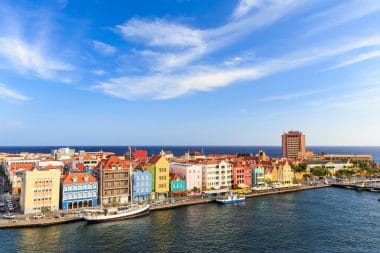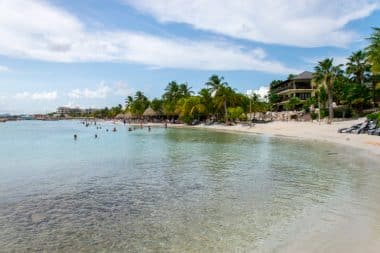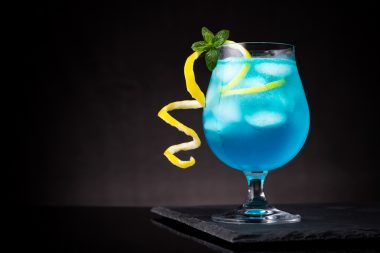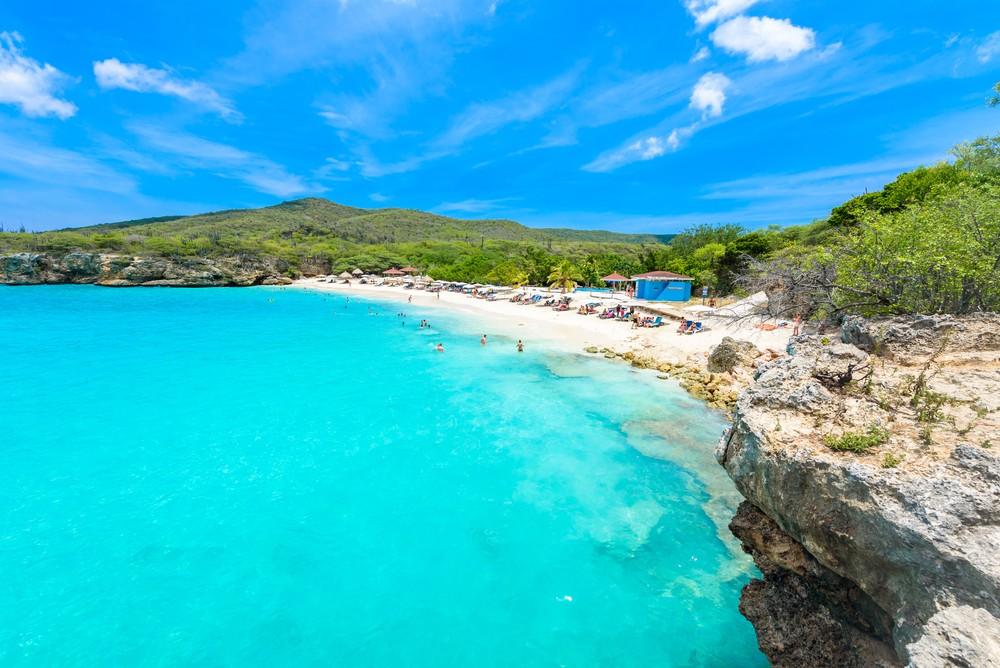Curacao is a special jewel among the ABC Islands, along with Aruba and Bonaire. As early as 4000 BC, the island was settled by the ancestors of the Arawak Indians . The cave paintings in the Hato Cave still bear remarkable witness today, which can also be visited. Gradually, the island suffered the same fate as its neighboring islands. It was first claimed by the Spaniards, then by the Dutch, English and Americans. What they all had in common was that they were primarily interested in the exploitation of natural resources.
In the past, the island of the Lesser Antilles was part of the Netherlands Antilles.
Not aware that they had the largest and most remarkable of all resources, nature, at their disposal. Despite all the hustle and bustle, the island, which measures just 444 square kilometers, managed to maintain its freshness to this day. At least for the most part. The practical center of the island also includes the fact that Venezuela is less than 60 km away and the neighboring islands, such as Klein Curacao, Bonaire and Aruba , can be reached by small boat. The Saphidic Jews, who had to flee Spain and Portugal in the 17th century and found a suitable island on the island, contributed significantly to the prosperity. This not only became a new home for them, but also served as a popular transshipment point for goods of all kinds, especially when the West India Trading Company founded its trading houses here.
The geographical and political situation

Curacao is located on the so-called South American continental plate and is referred to in philosophically tinged language as an island “under the winds”. In fact, Curacao is located outside the cyclone zone, which can cause severe damage outside of this zone. The capital “Willemstad” is the economic and social centre of the island.
The airport receives more than 2 million holidaymakers per year, but the island is spread over the whole year. That’s a good thing, one might think, as the population is barely more than 160,000 inhabitants. This good all-round distribution can also be seen as justified by the fact that the average daily temperature is around 30 degrees . Perennial. Continuous trade winds blowing from the northeast ensure that in the highest case and only in the evening you can get by with a very light sweater. However, this is except in the rainy season, which lasts from October to December.
Curacao and the modern era
Since the 20th century, when the Americans had finally finished cannibalizing the oil fields, the Dutch gradually found their way back in. In addition to Bonaire and Aruba, they also accepted Curaçao as their territory, but left it to their own responsibility. An elected council takes care of compliance with the laws and regulations, which are determined and supervised by an elected council chairman. Officially, the island kingdom is therefore part of the EU. The euro as well as the US dollar are considered a means of payment in the small island state.
Sights and beautiful places on Curacao
Christoffelpark
Christoffelpark is a national park in the north of the island. The national park gets its name from the Sint-Christoffelberg, which is located in the middle of the national park and offers the highest elevation on Curacao at 375 meters. The protected flora and fauna includes species that are rarely seen anywhere else in the world. For example, a special subspecies of white-tailed deer lives here, which only exists on Curacao. In addition, the birds and plants living in Christoffelpark amaze tourists. For example, tourists can admire the Cuban flamingo or meter-high cacti. The park, which includes tropical landscapes as well as beaches, ruins and a mine complex, can be explored by car or on foot. For hikers, there are eight designated routes with different levels of difficulty. The most popular is the one that leads to the Sint-Christoffelberg, because the view from there provides an unforgettable moment.
Westpunt
Westpunt is the westernmost point of the island, which is marked with a flag and is located near the city of Sabana Westpunt. Around this point are many beautiful beaches such as Playa Gipi or Playa Kalki. The latter is also called “Alice in Wonderland” because the mushroom-shaped corals there provide an unforgettable sight. The beaches in Sabana Westpunt are particularly popular for diving. In addition to simple snorkeling, diving with equipment is also offered. Not only can you observe the wonderful flora and fauna under water, but also numerous reefs and even a sunken plane wreck.
Ostrich Farm
Curacao is home to the largest ostrich farm beyond the African continent. The farm, located in the east of the island, offers tours in which tourists are driven around the grounds in a car and a guide tells them interesting information about the wildlife to be admired. Not only are there over 200 adult ostriches, but pigs, sheep, turtles and crocodiles are also native to the farm. After the tour, there is the possibility of direct contact with the ostriches, which may also be fed. In addition, tourists can eat specialties in the Zambezi restaurant or buy a souvenir of this unique experience in the souvenir shop.
Mambo Beach

As one of the longest sandy beaches in the world, Mambo Beach is definitely worth a visit. Since it is located directly in the capital Willemstad , it is very easy to reach. During the day, you can relax here with a picturesque backdrop. In addition, many restaurants invite you to have a meal and a shopping mile offers all kinds of shopping opportunities. At night, the clubs and bars on Mambo Beach are a popular destination, which can convince with live music in an idyllic ambience.
Mikvé Israel Emanuel Synagogue
Not far from Mambo Beach, also in Willemstad, is the Mikvé Israel Emanuel Synagogue, the oldest synagogue in the western hemisphere, which stands out from the outside with its yellow color. It is possible to visit this synagogue from the inside. There is a museum that deals with the history of Judaism on Curacao. The azure blue tinted glass windows and the sandy floor in the synagogue are a special experience.
Kura Hulanda Museum
A particularly popular museum on Curacao is the Kura Hulanda Museum, which is located in Sabana Westpunt. This museum deals with slavery in the West Indies. In addition, the art of the locals is exhibited there. Right next to the museum is the Hotel Kura Hulanda. By the way, this expression comes from the language of the locals and means “Dutch garden”.
Queen Emma Bridge
If you visit the capital Willemstad, you should definitely cross the Queen Emma Bridge, which connects the districts of Punda and Otrobanda. This bridge is a swing bridge, which means that it swings to the side when a ship enters the port. It does this regardless of whether there are people on it. That’s why it’s a lot of fun, especially for smaller children, to stand on this bridge. Furthermore, the bridge offers a wonderful view of Willemstad with its many colorful houses. Parts of this city are even protected as UNESCO World Heritage Sites.
Landhuis Chobolobo
For the more leisurely tourists, Landhuis Chobolobo is located in Willemstad. The world-famous Blue Curacao liqueur has been produced here since 1896. If you want to watch the production, you can book a guided tour. Of course, this ends with a tasting. In addition, the manufacturing process can also be learned in a workshop.
Hato Caves
Another attraction of Curacao are the Hato Caves on the north coast. These stalactite caves were formed several million years ago and served as shelter for escaped slaves for a long time. Highlights of the guided tours through the caves are certainly the underground lake and the cave paintings of the indigenous people. In addition, tourists can also meet bats during the tour, which creates a unique atmosphere in the damp cave. The difference to European caves, however, is that it is not cool inside, but relatively warm.
Liqueur and nature
The real wealth of the island, however, can be seen in the diversity of nature and the richness from which tourism in particular benefits. However, without it taking on exuberant forms as in other parts of the world. The coast of Curacao, like its neighbors, is considered a nature reserve. Compliance with environmental protection is also regarded as the highest good on this Isel and is rigorously monitored. Its importance is well known. More than in almost any other area of the island, one of the most species-rich faunas and floras can be found here. The clarity and purity of air and water are exemplary and form the basis for this biodiversity.
Curacao, the World Heritage Site

The center of Curacao, especially with the four districts »Otrabando«, »Scharloo«, »Ounda« and »Pietermaai« are part of the »UNESCO World Heritage Site« and are among the absolute must-sees of the island. The island has also earned a reputation for the world-famous blue liqueur, Blue Curacao, which is exported millions of times to all countries. The pastel facades of the colonial houses, the houses from the colonial era that contain everything from small supermarkets to souvenir shops and banks, to the church in the same pastel-like color. Curacao offers an atmosphere that is almost incomparable not only because of its rich history.
Curaçao – God’s Own Island
Admittedly, Curacao is only one of three islands that can be considered “God’s own island” in this area. Because with its two neighbors, Aruba and Bonaire, God has apparently created an island refuge that can hardly be found in this concentration anymore. Curacao has managed to retain its natural charm to this day, despite the numerous holidaymakers and the almost low population density. It is to be hoped that she and her little sisters will continue to do so in the future.
The most beautiful beaches on Curacao
Playa Porto Mari
Playa Porto Mari is one of the most famous beaches on Curacao and is often referred to as the most beautiful beach on the island. The beach has white sand and crystal clear waters that are ideal for snorkeling and diving. The beach is also equipped with sun loungers, umbrellas and a bar to provide maximum comfort to guests.
Cas Abao Beach
Cas Abao Beach is another beautiful beach on Curacao with white sand and turquoise waters. The beach is perfect for swimming, sunbathing and snorkeling. There is also a bar and restaurant where you can enjoy local specialties.
Klein Curacao
Klein Curacao is a small island off the coast of Curacao, known for its white sand and crystal clear waters. The beach is ideal for swimming, snorkeling, and diving, and also offers a great opportunity to see turtles and other marine life. You can reach Klein Curacao with a boat trip.
Grote Knip Beach
Grote Knip Beach is another beautiful beach on Curacao that is ideal for swimming and sunbathing. The beach has white sand and turquoise waters that are ideal for snorkeling and diving. There is also a bar and restaurant near the beach where you can enjoy local specialties.
Playa Lagun
Playa Lagun is a small beach surrounded by cliffs, making it ideal for snorkeling and diving. The beach also has a jetty from which you can jump into the water and swim. There is also a restaurant near the beach where you can enjoy local specialties.
Playa Kalki
Playa Kalki is another beautiful beach on Curacao with white sand and turquoise waters. The beach is ideal for snorkeling and diving, and also offers a great opportunity to see turtles and other marine life. There is also a restaurant near the beach where you can enjoy local specialties.
Blue Bay Beach
Blue Bay Beach is another beautiful beach on Curacao with white sand and crystal clear waters. The beach is perfect for swimming, sunbathing and snorkeling. There is also a restaurant near the beach where you can enjoy local specialties.


